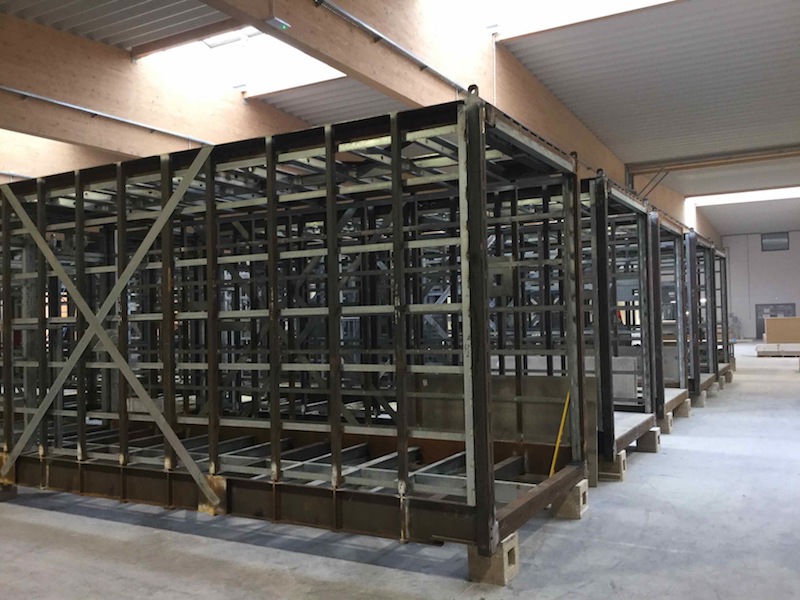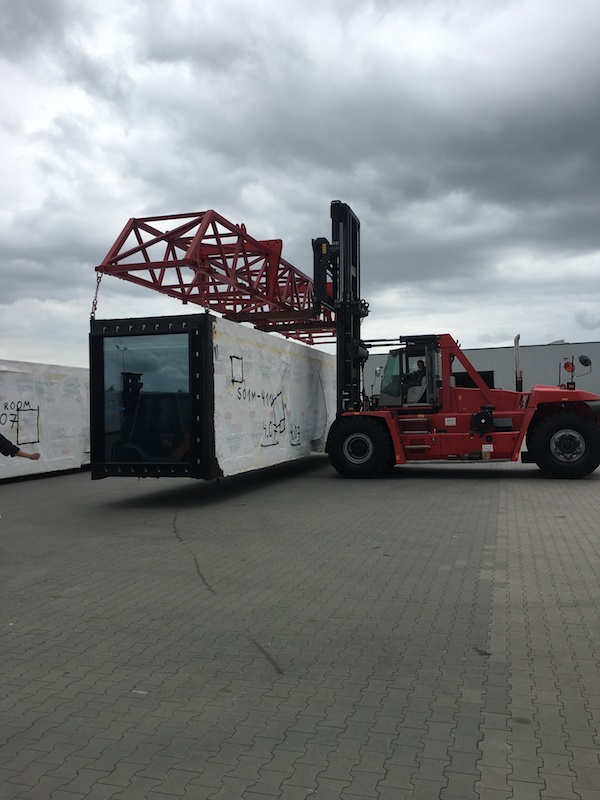Amsterdam-based hotelier citizenM has North America in its sites for major expansion that favors modular construction.
Having already opened two modular hotels in New York City, citizenM has two hotels under development in Los Angeles, including a 14-story, 183-ft, 216-key hotel at the intersection of Hollywood and Vine; and an 11-story, 315-room hotel at 4th and Spring Streets in L.A.’s historic Downtown Core.
CitizenM also has revealed plans to open two hotels in Seattle, and single hotels in Boston, Miami, San Francisco, and Washington DC.
See Also: DeSimone Consulting Engineers designs the tallest modular hotel in the United States
In Seattle, construction started in March on the 93,245-sf South Lake Union citizenM hotel, which Mortenson Construction is building with 228 steel-framed modular units that were prefabricated in Poland by Polcom, shipped 9,473 miles via the Panama Canal to the Port of Everett, Wash, and transported by truck to the jobsite.
 Steel-framed modules are shipped virtually complete, with beds, TVs, millwork, and bath fixtures installed. Image: Courtesy Mortenson
Steel-framed modules are shipped virtually complete, with beds, TVs, millwork, and bath fixtures installed. Image: Courtesy Mortenson
Polcom has supplied steel modules for numerous citizenM hotels in Europe, but wood framing or mass timber have been the more-common materials for modular projects in the U.S., even as height restrictions in most markets still limit the use of wood. “There is a large difference between wood frame modular construction and high-rise steel construction, which is what we are doing here in Seattle and in Los Angeles,” says Phillip Greany, Associate DBIA, LEED AP BD+C, general manager of Mortenson’s Seattle Operating Group in Kirkland, Wash.
The modules Polcom produces come virtually complete, with beds, wall-mounted TV screens, bathroom fixtures, doors and windows already installed. (The modules are wrapped in plastic and pressured to keep the components in place during transport.)

However, citizenM has brought on Gensler to design several of the hotels it is opening in the U.S., to ensure those buildings meet local Building, MEP, and Energy codes. (South Lake Union will be the first modular hotel in Seattle.) “There is also a major ground floor and basement that are conventionally built,” explains Greany, and will include an expansive lobby, a 24/7 canteenM food and beverage amenity, and four meeting areas.
He estimates that construction will take 13 months to complete, and that the 264-key Seattle hotel will be up and running by June 2019.
Related Stories
| Apr 29, 2014
USGBC launches real-time green building data dashboard
The online data visualization resource highlights green building data for each state and Washington, D.C.
| Apr 28, 2014
Welcome to the Hive: OVA designs wild shipping container hotel for competition
Hong Kong-based OVA envisions a shipping-container hotel, where rooms could be removed at will and designed by advertisers.
| Apr 25, 2014
A radiant barrier FAQ: Everything you wanted to know but were afraid to ask
There are many examples of materials developed for the space program making their way into everyday life and radiant barriers are just that. SPONSORED CONTENT
| Apr 23, 2014
Developers change gears at Atlantic Yards after high-rise modular proves difficult
At 32 stories, the B2 residential tower at Atlantic Yards has been widely lauded as a bellwether for modular construction. But only five floors have been completed in 18 months.
| Apr 17, 2014
6 details that can throw off your schedule
In 1997, Apple told us to “Think Different.” So we did. We thought about what could happen if the world went mobile, if information was boundless, if we could carry our office in our back pocket. We’ve grown to love different and to expect change. And when it comes to Apple products, that’s not such a bad thing. When it comes to your building order, however, it’s not nearly as appealing.
| Apr 9, 2014
Steel decks: 11 tips for their proper use | BD+C
Building Teams have been using steel decks with proven success for 75 years. Building Design+Construction consulted with technical experts from the Steel Deck Institute and the deck manufacturing industry for their advice on how best to use steel decking.
| Apr 2, 2014
8 tips for avoiding thermal bridges in window applications
Aligning thermal breaks and applying air barriers are among the top design and installation tricks recommended by building enclosure experts.
| Mar 31, 2014
Tips for creating a competitive bid using codes and loads
Landing a project feels like winning a prize, sort of like finding that forgotten $20 bill in the pocket of a pair of jeans you haven’t worn in a while. But living on the “chance” of winning a job isn’t a great way to pay your electric bill. So, how do you swing the chances in your favor?
| Mar 26, 2014
A sales and service showcase
High Plains Equipment, a Case IH dealership in Devils Lake, N.D., constructs a larger facility to better serve its customers.
| Mar 26, 2014
Callison launches sustainable design tool with 84 proven strategies
Hybrid ventilation, nighttime cooling, and fuel cell technology are among the dozens of sustainable design techniques profiled by Callison on its new website, Matrix.Callison.com.

















